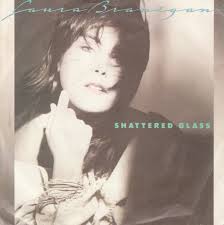Laura Branigan – Shattered Glass
It’s almost impossible to discuss pop music at the end of the 1980s without mentioning Stock, Aitken and Waterman. For the last two years of the decade they essentially colonised the UK charts, scoring 13 number ones and more than 100 top 40 hits, subsequently inspiring a level of hate not seen since the “Disco sucks” campaign of 1979. Yes, they were that good.
It’s always been easy to scoff at what S/A/W achieved – none of their acts (bar Kylie) posed a genuine threat to any of the superstars of the time. Yet collectively they formed a magnificent DIY army that almost anyone (see The Reynolds Girls) could join. You needed only the barest modicum of singing talent (bolstered by the mysterious Calrec Soundfield Microphone) and the ability to do exactly as you were told. When it worked – as with Kylie – they were unbeatable: as throwaway as a bag of chips but as memorable as a first decent snog. When it didn’t work – as with Mandy Smith – they just gave the record to Kylie or Sinitta and then it did. But the classics – Better the Devil You Know, Never Gonna Give You Up, Toy Boy – are as good as anything in the wider pop pantheon.
S/A/W were principally known for turning people into pop stars e.g.) Rick Astley and Sonia, but what would happen when they collided with someone who was already famous and an incredible vocalist? That question was answered when they teamed up with Donna Summer for 1989’s Another Place and Time album: magic would happen. Its first single This Time I Know It’s For Real was possibly their best moment overall – joyous, sophisticated, and perfectly sung – and became a massive hit on both sides of the Atlantic.
But this wasn’t the first time it had happened. In 1987 the trio were drafted in to rescue the career of another American pop legend – Laura Branigan, who’d enjoyed two massive UK hits with Gloria and the cruising classic Self Control. Only this time it wasn’t for real – and despite being as good as anything they later produced for Donna, Shattered Glass proved to be the last time Laura would trouble the UK charts.
An early empowerment anthem (“You can shatter glass with your heart of stone, but you won’t get far on your own”) Shattered Glass has an enjoyably literal video which begins with Laura bursting through a pane of glass looking faintly terrified, and is fairly unusual for a S/A/W production because they didn’t actually write it. But as they proved with any number of cover versions, it’s hard to tell the difference once their pop sheen was applied. The production positively glistens with crystal-clear icy synths, their trademark chug-chug all the way through and plenty of pauses for dramatic hand movements. The entire thing is lifted by a quite incredible vocal from Laura – I defy you not to get goosebumps when she belts out “and everything you hold just falls apart like sha-aaattered glass.”
Shattered Glass possesses every single quality of the classic S/A/W smash hit sound – so why wasn’t it? I lay the blame squarely at the door of Atlantic Records – they had a great track record with soul and rock, but weren’t quite so effective when it came to pop. Stock, Aitken and Waterman had four records in the UK top 40 at the time and Rick Astley‘s Never Gonna Give You Up was just about to rocket to no.1, so the hit was theirs for the taking. They just forgot to tell anyone about it.
Chart peak: 78
Weeks on chart: 3
Who could sing this today and have a hit? CARLY RAE JEPSEN.





Also, her drummer is HAWT.
LikeLike
Johnny, for the life of me, I cannot find that guy’s name anywhere. I have tried everything I can to see what he looks like today. If you find him, let me know, Mate. LOL I agree…could watch him all day! 🙂 CHEERS!
LikeLike
Again S A W used more samplers and computerized technology at that time than synth sounds, synths only ever Lightly embellished music of the mid to late 80s, the ‘chuga chuga’ sound that u speak of is in fact, a sampled fretless guitar bass sound from the fairlight cmi and emulator samplers, , they also always used the LINNDRUM and LINN9000 both digital sample playback drum computers or ‘machines’ created by roger linn, the linn 9000 had the ability to actually sample user sounds in on spec, where as the linndrum had samples on eproms which have to be removed via a ziff socket.
LikeLike
I love this song and also like Ellie Warren doing it too. I still play both versions on vinyl.
LikeLike
Reblogged this on Hit Rewind 80s.
LikeLike
You had me at Stock Aitken & Waterman!
LikeLike
Same happened to the S/A/W- re-recording of Debbie Harry’s “In Love With Love”. It was all there: a great artist with an impressive chart history, a recent Top Ten smash (“French Kissin”), great tune, danceable and catchy. Why that single bombed is beyond me.
LikeLike